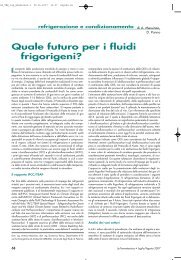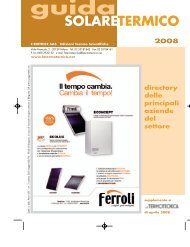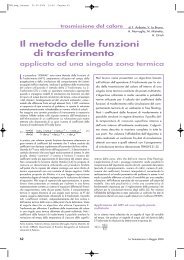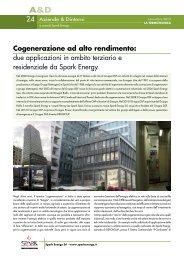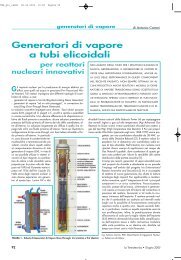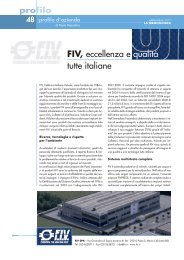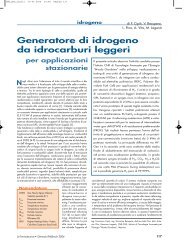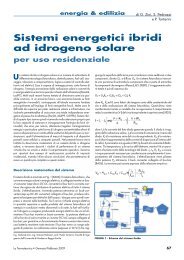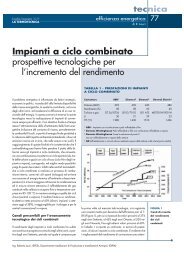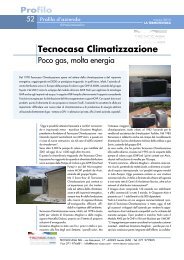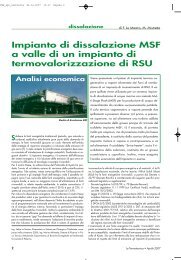Articolo scaricabile gratuitamente in PDF (296 Kb) - La Termotecnica
Articolo scaricabile gratuitamente in PDF (296 Kb) - La Termotecnica
Articolo scaricabile gratuitamente in PDF (296 Kb) - La Termotecnica
Create successful ePaper yourself
Turn your PDF publications into a flip-book with our unique Google optimized e-Paper software.
trasmissione del calore<br />
Dall’equazione (1) si nota <strong>in</strong>oltre che la temperatura e la pressione di<br />
saturazione del fluido nell’evaporatore dipendono anche dalla densità<br />
e dalla curva di tensione del fluido di lavoro e qu<strong>in</strong>di con basse temperature<br />
dell’evaporatore a parità di altre condizioni. Nella seconda<br />
parte di questo articolo saranno presentati i risultati dell’ampia <strong>in</strong>dag<strong>in</strong>e<br />
sperimentale eseguita e considerazioni quantitative della possibilità<br />
di impiego di un termosifone bifase come elemento di controllo termico<br />
di dispositivi elettronici.<br />
Bibliografia<br />
FIGURA 4 - Rappresentazione schematica dei term<strong>in</strong>i<br />
che compongono la resistenza termica globale di un PTPT<br />
R m rappresenta la resistenza che caratterizza lo scambio termico che<br />
avviene nell’accumulatore tra il fluido vettore e la sorgente a temperatura<br />
T f . Nel caso di un PTPT che abbia raggiunto il regime periodico stabilizzato<br />
è possibile def<strong>in</strong>ire la resistenza termica globale con la formula:<br />
Nella quale T w rappresenta la temperatura della parete del dissipatore<br />
e T f la temperatura della sorgente termica verso la quale il calore viene<br />
dissipato. Nel caso di un PTPT che abbia raggiunto il regime periodico<br />
stabilizzato ed <strong>in</strong> accordo con lo schema di figura 4 la resistenza termica<br />
globale può essere posta nella forma:<br />
Supponendo <strong>in</strong>oltre che la potenza termica smaltita dall’accumulatore<br />
sia trascurabile rispetto alla quota dissipata nello scambiatore con la<br />
sorgente fredda, per cui Q m sia circa zero e R m sia molto maggiore delle<br />
altre resistenze termiche, l’equazione (3) diventa:<br />
dove il secondo term<strong>in</strong>e rappresenta la resistenza termica dello scambiatore<br />
con la sorgente fredda che può essere def<strong>in</strong>ita, nella sua globalità,<br />
come la differenza di temperatura T E -T fratto la potenza termica Q f. e cioè:<br />
Con le ipotesi sopra espresse la resistenza termica globale dipende<br />
esclusivamente dalla resistenza termica ebollitiva e da quella dello<br />
scambiatore con la sorgente fredda. Scambiatori più efficienti permettono<br />
di avere una temperatura di uscita del fluido molto prossima a<br />
quella della sorgente fredda e qu<strong>in</strong>di una temperatura dell’accumu -<br />
latore più bassa. Il verificarsi di tale condizione permette all’evapo -<br />
ratore di operare con temperature più basse <strong>in</strong> virtù dell’equazione (1).<br />
(2)<br />
(3)<br />
(4)<br />
(5)<br />
[1] Ryan J. McGlen, Roshan Jachuck, Song L<strong>in</strong>, Integrated thermal<br />
management techniques for high power electronic devices,<br />
Applied Thermal Eng<strong>in</strong>eer<strong>in</strong>g, Volume 24, Issues 8-9, June 2004,<br />
Pages 1143-1156.<br />
[2] Manfred Groll, Marcus Schneider, Valérie Sartre, Mohamed<br />
Chaker Zaghdoudi, Monique <strong>La</strong>llemand, Thermal control of electronic<br />
equipment by heat pipes Revue Générale de Thermique, Volume<br />
37, Issue 5, May 1998, pp. 323-352.<br />
[3] Peterson G. P., An Introduction to Heat Pipes, Model<strong>in</strong>g, Test<strong>in</strong>g<br />
and Applications, John Wiley & Sons Inc., New York, 1994.<br />
[4] Leonid Vasiliev, et al., Loop heat pipe for cool<strong>in</strong>g of high-power<br />
electronic components, International Journal of Heat and Mass<br />
Transfer,In Press, Corrected Proof, 2008.<br />
[5] Krustalev D., Loop Thermosyphons for Cool<strong>in</strong>g of Electronics, 18th<br />
IEEE SEMI-THERM Symposium, 2002.<br />
[6] S.H. Rhi, Y. Lee, Two-phase loop thermosyphons for cool<strong>in</strong>g of<br />
electronic system, Celata, Di Marco, Shah (Eds.), Two-phase Modell<strong>in</strong>g<br />
an Experimentation, Pisa (Italy), 1999, pp. 561-568.<br />
[7] Pastukhov V.G., Maydanik Y.F., Development and Results of Test<strong>in</strong>g<br />
Coolers on the basisi of Copper-Water LHPs for Desktop PCs,<br />
14 th International Heat Pipes Conference, April 2007, Florianopolis<br />
(Br), pp. 157-162.<br />
[8] Chen Y., Groll M., Mertz R., Maydanik Y.F., Versh<strong>in</strong><strong>in</strong> S.V.,<br />
Steady-state and transient performance of a m<strong>in</strong>iature loop heat<br />
pipe, International Journal of Thermal Science, 2006, Vol. 45, pp.<br />
1.084-1.090.<br />
[9] Fantozzi F., Filippeschi S. (2002), Pulsated Two-Phase Thermosyphons<br />
for Electronic Equipements Thermal Control, 32 nd .<br />
[10] Filippeschi S., On the Periodic Two-Phase Thernosyphons Operat<strong>in</strong>g<br />
Aga<strong>in</strong>st Gravity, International Journal of Thermal Science,<br />
vol. 45, 2006, pp. 124-137.<br />
[11] Fantozzi F., Filippeschi S., <strong>La</strong>trofa E. (2003), M<strong>in</strong>iature Pulsated<br />
Loop Thermosyphon for Desktop Computer Cool<strong>in</strong>g: Feasibility<br />
Study and First Experimental tests, 5th Sem. on Heat Pipes, Heat<br />
Pumps, Refrigerators, M<strong>in</strong>sk, Belarus, 2003.<br />
[12] Fantozzi F., Filippeschi S., <strong>La</strong>trofa E., Upward and downward heat<br />
and mass transfer with m<strong>in</strong>iature periodically operat<strong>in</strong>g loop thermosyphons,<br />
Superlattices and microstructure, vol. 35, 3-6, March-<br />
June 2004, pp 339-351. ISSN 0749-6036.<br />
[13] Filippeschi S., E. <strong>La</strong>trofa, G. Salvadori, Periodic two-phase heat<br />
transfer coefficient <strong>in</strong> thermoelectric cool<strong>in</strong>g m<strong>in</strong>i evaporator, International<br />
Journal of Low Carbon Technologies, vol 1, issue 4, 2006,<br />
pp. 298-314.<br />
[14] Salvadori G., Rilievi sperimentali sui termosifoni bifase operanti<br />
<strong>in</strong> controgravità, Tesi di <strong>La</strong>urea <strong>in</strong> Ingegneria Aerospaziale, Università<br />
di Pisa, Aprile 2002.<br />
[15] Filippeschi S., Salvadori G., Analisi Numerica delle Prestazioni di<br />
un Dissipatore termico a Funzionamento Periodico, 59° Congresso<br />
Nazionale ATI, Genova, Settembre 2004, Atti vol. III, pp. 2093-<br />
2106. ISBN 88-86281-93-5. ■<br />
70 <strong>La</strong> <strong>Termotecnica</strong> • Aprile 2009



